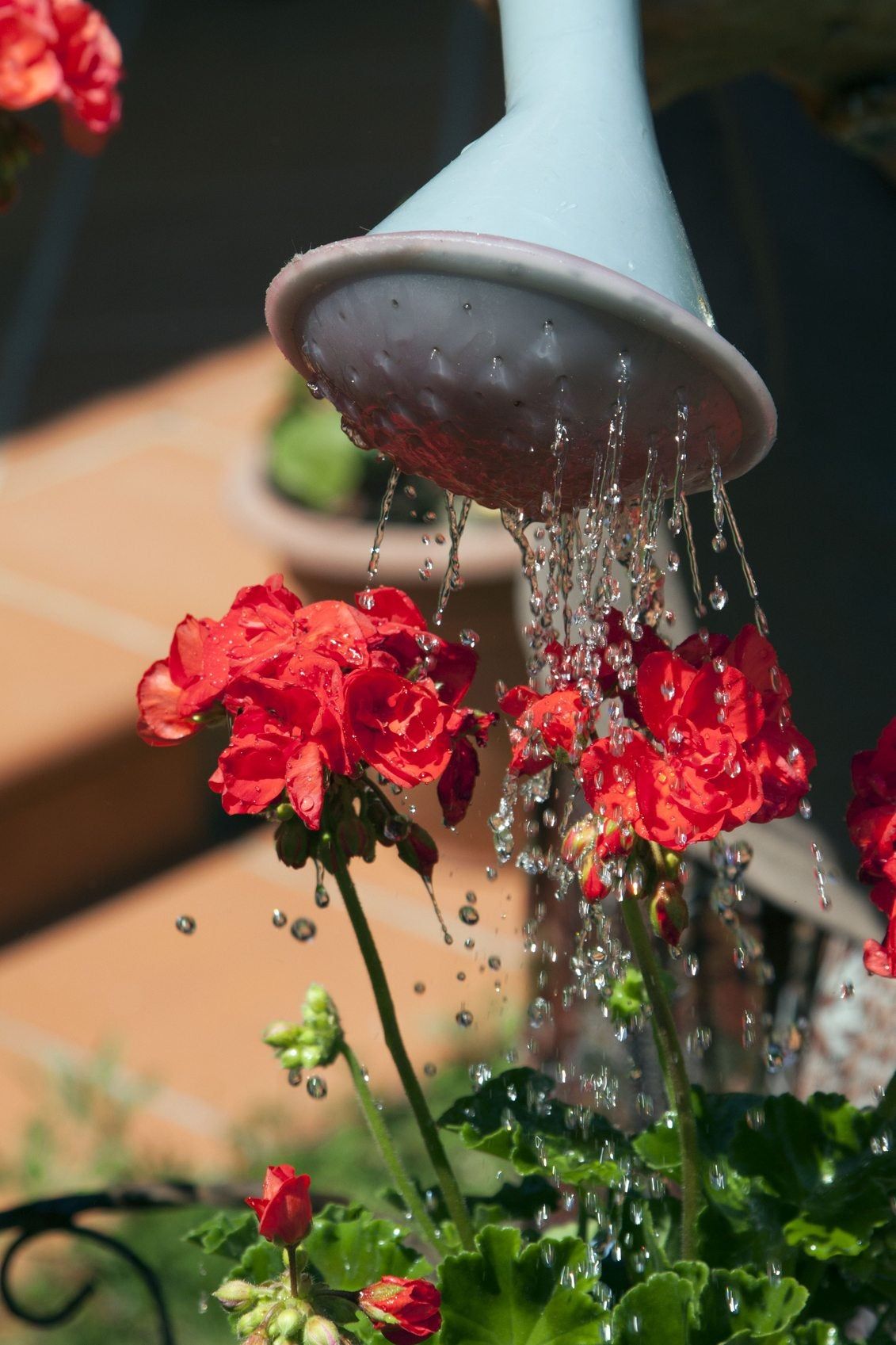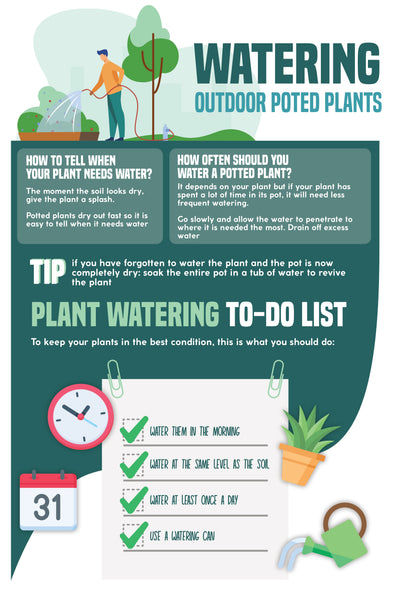As an Amazon Associate, I earn from qualifying purchases.
Water outdoor potted plants every 1-2 days in hot weather. Adjust to every 3-4 days in cooler conditions.
Outdoor potted plants require consistent watering to thrive. Proper hydration ensures healthy growth and vibrant blooms. Container plants dry out quicker than those in the ground due to limited soil volume. Monitoring the soil moisture is crucial. Stick your finger into the soil; if the top inch is dry, it’s time to water.
Different plants have varying water needs, so research specific requirements. Morning watering is best to reduce evaporation. Ensure pots have drainage holes to prevent root rot. Mulching can help retain moisture. By understanding your plant’s needs and adjusting your watering schedule, you can maintain a flourishing garden all season long.

Credit: savvygardening.com
Factors Affecting Watering Frequency
Understanding how often to water your outdoor potted plants can be tricky. Various factors influence the watering frequency. This section explores the key factors to help you keep your plants healthy and thriving.
Climate Considerations
The climate where you live plays a vital role in watering frequency. In hot, dry climates, water potted plants more often. In cooler, humid areas, plants need less frequent watering. Always check the weather forecast. Rain can reduce the need for watering.
Soil Type Influence
The type of soil in your pots affects how often you need to water. Sandy soil drains quickly and needs frequent watering. Clay soil retains moisture longer, requiring less frequent watering. Loamy soil strikes a balance and offers moderate watering needs.
| Soil Type | Watering Frequency |
|---|---|
| Sandy | Frequent |
| Clay | Less Frequent |
| Loamy | Moderate |
Pot Material Impact
The material of the pot also affects watering needs. Clay pots are porous and lose water quickly. Plastic pots retain moisture longer. Glazed ceramic pots hold water well but can overheat in the sun.
- Clay Pots: Water more often.
- Plastic Pots: Water less frequently.
- Glazed Ceramic Pots: Monitor for overheating.
Signs Your Plants Need Watering
Knowing when your outdoor potted plants need water is key. Watch for specific signs to keep them healthy. Here are the top signs your plants need watering:
Wilting Leaves
Wilting leaves are a clear sign. They look limp and droopy. This means the plant lacks water. Water it right away.
Soil Dryness
Check the soil often. If the top inch feels dry, it’s time to water. Dry soil means the roots can’t get water.
Yellowing Foliage
Yellow leaves can mean many things. One common cause is lack of water. If you see yellowing, check the soil and water as needed.
Optimal Watering Techniques
Watering outdoor plants in pots can be tricky. Different plants have different needs. Understanding optimal watering techniques can help keep your plants healthy. Below, we discuss three effective methods: Deep Watering Method, Surface Watering, and Using Self-Watering Pots.
Deep Watering Method
The Deep Watering Method ensures water reaches the roots. This method is great for encouraging strong root growth.
- Water slowly until water runs out of the drainage holes.
- Do this early in the morning or late in the evening.
- Deep water once a week for most plants.
Deep watering helps plants grow deep roots. Deep roots make plants stronger and healthier.
Surface Watering
Surface Watering is quick and easy. This method is useful for plants with shallow roots.
- Use a gentle shower or watering can.
- Water the surface of the soil evenly.
- Do this every other day to keep the soil moist.
Surface watering works well for small pots and seedlings. It prevents the soil from drying out too quickly.
Using Self-watering Pots
Self-Watering Pots are a convenient option. These pots have built-in water reservoirs.
| Benefits | How to Use |
|---|---|
|
|
Self-watering pots are great for busy gardeners. They ensure your plants get the right amount of water.

Credit: www.gardeningknowhow.com
Seasonal Watering Guidelines
Understanding seasonal watering guidelines is crucial for healthy outdoor plants in pots. Different seasons demand different watering techniques. This ensures plants thrive throughout the year. Let’s explore the best practices for each season.
Spring And Summer
During spring and summer, plants grow rapidly. They require more water to support their growth. Water your plants early in the morning. This helps them absorb water before the heat of the day.
- Water daily or every other day.
- Ensure the soil is moist but not soggy.
- Check the top inch of soil; if dry, water the plant.
Place a saucer under each pot to catch excess water. This helps keep the roots hydrated. Use a watering can with a long spout for better control. This prevents water from spilling.
Fall And Winter
In fall and winter, plants enter a dormant phase. They need less water during these cooler months. Overwatering can lead to root rot.
- Water once a week or less.
- Check the soil moisture before watering.
- Let the top two inches of soil dry out.
Reduce watering as temperatures drop. Use a moisture meter to check soil moisture levels. This ensures you don’t overwater your plants. Consider moving pots to sheltered areas. This protects them from frost and excess rain.
| Season | Watering Frequency | Soil Condition |
|---|---|---|
| Spring and Summer | Daily or every other day | Moist but not soggy |
| Fall and Winter | Once a week or less | Top two inches dry |
Watering Tools And Accessories
Choosing the right watering tools and accessories can make caring for your outdoor potted plants easier. These tools help ensure your plants get the right amount of water. Let’s explore some essential watering tools and accessories.
Watering Cans
Watering cans are simple yet effective. They allow you to direct water precisely where needed. Look for a watering can with a long spout. This helps you reach all parts of the plant. Choose a can with a comfortable handle. This makes it easier to carry when full.
| Material | Durability | Weight |
|---|---|---|
| Plastic | Moderate | Light |
| Metal | High | Heavy |
Garden Hoses
Garden hoses are ideal for larger areas. They help you water multiple pots quickly. Choose a hose with a spray nozzle. This allows you to adjust the water flow. A hose with an adjustable length is also useful. This ensures it can reach all parts of your garden.
- Choose a durable hose material
- Opt for kink-resistant hoses
- Ensure the spray nozzle has multiple settings
Soil Moisture Meters
Soil moisture meters help you know when to water your plants. Insert the meter into the soil to check moisture levels. A digital meter gives precise readings. This helps you avoid overwatering or underwatering your plants.
- Insert the probe into the soil
- Read the moisture level on the display
- Water your plant if the soil is dry
Using these tools ensures your outdoor potted plants stay healthy and hydrated.
Common Watering Mistakes
Watering outdoor plants in pots can be tricky. Many gardeners make common mistakes that harm their plants. Here are some of the most frequent errors.
Overwatering Issues
Overwatering is a common problem. It can cause root rot and kill plants.
- Roots can’t breathe: Too much water fills the air gaps in the soil.
- Fungal growth: Wet soil encourages fungi, which can damage plants.
- Nutrient washout: Excess water washes away essential nutrients.
Underwatering Risks
Underwatering is just as harmful as overwatering. Plants need water to thrive.
- Wilting: Lack of water causes plants to wilt and droop.
- Poor growth: Plants can’t grow well without enough water.
- Leaf drop: Dry soil can make leaves fall off.
Improper Timing
Watering at the wrong time can stress plants. The best time to water is early morning or late evening.
| Time of Day | Effect on Plants |
|---|---|
| Morning | Gives plants time to absorb water before it gets hot. |
| Evening | Reduces water loss due to evaporation. |
| Afternoon | Water evaporates quickly, leaving less for plants. |
Don’t water during the hottest part of the day. The water will evaporate too quickly.
Tips For Specific Plant Types
Watering outdoor plants in pots can vary. Different plants have different needs. Here are tips for specific plant types. This helps ensure your plants thrive.
Flowering Plants
Flowering plants need regular watering. Check the soil often. Keep the soil moist but not soggy. Use this guide for common flowering plants:
| Plant Type | Watering Frequency |
|---|---|
| Roses | Once a week |
| Geraniums | Every 3 days |
| Petunias | Every 2 days |
Water early in the morning. This helps prevent diseases. Use a watering can with a fine spout.
Succulents And Cacti
Succulents and cacti need less water. They store water in their leaves and stems. Follow these tips:
- Water once every 2-3 weeks.
- Ensure the soil is dry before watering again.
- Use a pot with good drainage.
Overwatering can cause root rot. It’s better to underwater than overwater.
Herbs And Vegetables
Herbs and vegetables need consistent moisture. Check the soil daily. Here is a guide:
- Basil: Water every 2 days.
- Tomatoes: Water every 3 days.
- Mint: Water every day.
Water the soil, not the leaves. This helps prevent mold and mildew. Mulch can help retain moisture. Use organic mulch around the base of your plants.
Maintaining Consistent Moisture Levels
Keeping outdoor plants in pots properly watered is crucial. Plants in pots dry out faster than those in the ground. Maintaining consistent moisture levels helps plants thrive and stay healthy.
Mulching Benefits
Mulching helps retain soil moisture. It also reduces the need for frequent watering. Use organic mulch like straw or wood chips. These materials break down and enrich the soil. Mulch also helps regulate soil temperature. This protects plant roots from extreme heat or cold.
Grouping Plants With Similar Needs
Group plants with similar water needs together. This makes watering easier and more efficient. For example, succulents need less water than ferns. Placing them together helps avoid over or under-watering. This strategy also helps conserve water.
Regular Monitoring
Check soil moisture regularly. Stick your finger about 2 inches into the soil. If it’s dry, water the plant. Use a moisture meter for more accurate readings. Adjust your watering schedule based on weather conditions. Hot and windy days may require more frequent watering.

Credit: savvygardening.com
Frequently Asked Questions
How Often To Water Outdoor Potted Plants?
Water outdoor potted plants when the top inch of soil is dry. This usually means watering every 2-3 days. Frequency may vary with weather conditions.
Best Time To Water Outdoor Potted Plants?
The best time to water outdoor potted plants is early morning. This allows the water to soak in before the heat of the day.
How To Check If Potted Plants Need Water?
Check if potted plants need water by feeling the soil. If the top inch is dry, it’s time to water.
Can Overwatering Harm Outdoor Potted Plants?
Yes, overwatering can harm outdoor potted plants. It can cause root rot and other issues. Ensure proper drainage.
Conclusion
Watering outdoor potted plants requires attention to their specific needs. Check soil moisture regularly and adjust watering accordingly. Seasonal changes and plant types also affect watering frequency. By understanding these factors, you can keep your plants healthy and thriving. Remember, consistency and observation are key to successful plant care.

